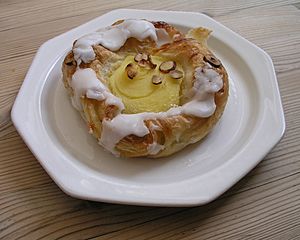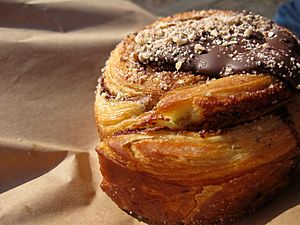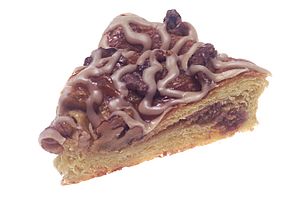Danish pastry facts for kids

A typical Spandauer-type Danish with apple filling and glazing
|
|
| Type | Sweet bread |
|---|---|
| Place of origin | Denmark, Austria |
| Main ingredients | Wheat flour, butter, milk, eggs, yeast. |
A Danish pastry (called Wienerbrød in Danish) is a yummy, layered sweet bread. It's a type of pastry known as viennoiserie. Think of it like a fancy croissant! It has many thin layers, making it light and crispy. This special pastry came to Denmark from Austrian bakers. The Danes loved it so much, they changed the recipe a bit to make it their own. Now, it's a famous Danish treat enjoyed all over the world.
Danish pastries became popular in the United States when immigrants brought them over. There, they often have fruit or cream cheese on top. Today, people enjoy Danish pastries in many countries.
Contents
What's Inside a Danish Pastry?
Danish pastry is made from a special dough. This dough uses wheat flour, milk, eggs, sugar, and lots of butter. It also has yeast, which helps the dough rise and become fluffy.
To make it super layered, bakers roll out the dough very thin. Then, they put thin slices of butter between the layers. The dough is folded and rolled many times. This creates about 27 thin layers! Sometimes, the dough is chilled to make it easier to work with. This special process makes the pastry light and crispy on the outside. It also makes it rich and buttery inside.
Traditionally, butter is used for Danish pastries. But sometimes, in big bakeries, they might use other fats like sunflower oil.
What's in a Name?
In countries like Denmark, Norway, and Sweden, Danish pastry is called wienerbrød. This means "Viennese bread." Vienna is a city in Austria. The name also led to the Finnish word viineri and Estonian Viini sai, which also mean "Viennese pastry."
In Vienna, Austria, they call this pastry Kopenhagener Plunder. This name refers to Copenhagen, the capital city of Denmark.
How Danish Pastry Began
The story of Danish pastry often starts with a strike. In 1850, bakery workers in Denmark went on strike. Because of this, bakery owners hired bakers from other countries. Some of these new bakers came from Austria. They brought their own baking traditions and recipes with them.
An Austrian pastry called Plundergebäck quickly became popular in Denmark. After the strike ended, Danish bakers started using these Austrian recipes. They changed them a bit, adding more egg and fat. This is how the Danish pastry we know today was created!
One important technique the Austrian bakers shared was the Viennese lamination technique. This is the special way of folding butter into the dough to create layers. Because of these new ideas, the Danes called the pastry "wienerbrød" (Vienna bread). This name is still used in Northern Europe today. Back then, many baked goods in Denmark were given names from other countries.
Danish Pastries in Denmark
Danish pastries in Denmark come in many different shapes and with various toppings. Some have chocolate, pearl sugar, or glacé icing. Others might have chopped nuts. They can also be filled with tasty things like jam (often apple or prune), remonce (a sweet paste), marzipan, or custard.
The shapes are fun and varied! You can find circles with filling in the middle, called Spandauers. There are also figure-eights, spirals (like snails), and pretzel-shaped ones called kringles.
Different Kinds of Danish Pastries
In Sweden, Danish pastries are usually made in the Spandauer style. They often have vanilla custard inside.
In the UK, bakers add different ingredients. These include jam, custard, apricots, cherries, raisins, flaked almonds, or pecans. Sometimes, they even add caramelized toffee. Cardamom spice is often added to make them smell and taste even sweeter.
In the US, Danishes usually have a topping of fruit or sweetened cream cheese before baking. Danishes with nuts are also popular there and in Sweden. They often have icing, powdered sugar, or chocolate drizzled on top.
In Argentina, Danish pastries are often filled with dulce de leche (a sweet caramel sauce) or dulce de membrillo (quince paste).
Images for kids
-
Argentine facturas with dulce de membrillo
-
Danish pastries in the Philippines
Danish Pastry in the United States
Danish pastry came to the United States thanks to Danish immigrants. A man named Lauritz C. Klitteng helped make "Danish pastry" famous in the US around 1915 to 1920. Klitteng even said he made Danish pastry for the wedding of President Woodrow Wilson in 1915. He traveled the world to share his pastry and was featured in baking magazines. Klitteng even had his own Danish Culinary Studio in New York City for a short time.
Herman Gertner, who owned restaurants in New York City, helped Klitteng introduce Danish pastry. Gertner's obituary in 1962 mentioned that he met a Danish baker who thought Danish pastry would do well in New York. Gertner started serving it in his restaurants, and it was an instant hit!
See also
 In Spanish: Wienerbrød para niños
In Spanish: Wienerbrød para niños









